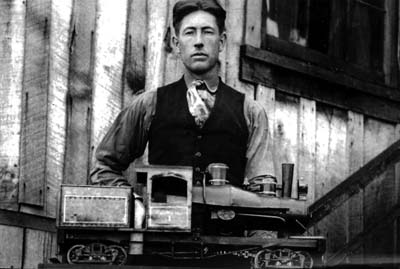Dira Stout Sr.: Steam Locomotive Prodigy
By Alan Byer

Fayette County inventor Dira Stout Sr. with his model of a Heisler geared locomotive, submitted with his paperwork to the U.S. Patent Office in 1918. Photo courtesy of Dira Stout Jr.
Dira Stout Jr. knew that his father and namesake was a talented machinist and mechanic, but he understood neither the true extent of his abilities nor his accomplishments—until after Dira Sr. departed this life on February 18, 1988.
Following the funeral and burial, Dira was cleaning out his father’s workshop in King George, Virginia, when he discovered an ancient-looking toolbox beneath a workbench. He opened the lid and, under some tools, found five sheets of paper folded together. Though silverfish had left the paper tattered and full of holes, he could just make out the words “UNITED STATES PATENT OFFICE” near the top of one page, along with his father’s name in one corner and a long number in the other.
On a hunch, Dira asked a computer-savvy granddaughter to research the matter. Pretty soon, she had an answer. His father had been granted a patent 70 years earlier for improvements to Heisler geared steam locomotives. Dira talked to his siblings, and they were just as surprised as he was; their father had kept this remarkable accomplishment secret as long as they’d known him.
Dira Stout Sr. was born July 16, 1893, in New Milton, Doddridge County. He was an orphan by age seven and, for the next decade, was raised by grandparents, aunts, and uncles on his mother’s side, all with the last name McIe (pronounced MACKee). Though he attended school through fifth grade, he missed many days to help with planting, tending, and harvesting crops; according to Dira Jr., his father probably had more of a third-grade education. When Dira Sr. was 16, he made his way 120 miles due south to Landisburg, Fayette County, where he found work cutting timber for the Sewell Lumber Company for 70 cents a day. Every morning, he’d walk about two-and-a-half miles from the camp to the timber-cutting site in the woods carrying a crosscut saw and a double-bit axe. At the end of the workday, he’d retrace his steps back to camp.
Before long, he found more rewarding work in the mill and as an extra-board locomotive engineer for the company’s narrow-gauge railroad (three feet between the rails instead of the standard gauge, four-feet, eight-and-a-half inches.) On log trains, he moved empty cars into the woods and loaded cars back to the mill; on freight trains, he took finished timber products downgrade to Sewell at the foot of the New River Gorge—to connect with the Chesapeake & Ohio (C&O) Railway—and supplies and empties back up to Landisburg.
When Dira Sr. started, the company operated Climax and Shay geared locomotives and two old rod locomotives built by Baldwin Locomotive Works. Sewell Lumber and its successor, Babcock Coal and Lumber, maintained their own locomotive shops in Landisburg and nearby Clifftop. Before long, Dira was working full time as an engineer and as a mechanic in the repair shop, where he, and his employer, discovered his natural aptitude for repairing steam locomotives. Dira learned quickly, so much so that his abilities soon surpassed those of everyone else in the shop. He became the go-to mechanic whenever his coworkers had trouble completing a task.
Dira was a young man in his prime, and, before long, the daughter of a neighbor and fellow employee caught his eye. Winifrede “Winnie” Zickafoose and Dira became sweethearts and, before long, were married at the home of Dira’s Uncle John in Diana, Webster County. Dira was 19 years old.
Soon, Dira was running the Landisburg shop, though he made no more money for the added responsibility. He knew he could do better and, with a growing family to support, started looking for a better job. Wilderness Lumber Company operated five geared locomotives, four Shays and one Heisler, to supply logs to its mill in nearby Nallen, which straddles the Fayette-Nicholas county line. Wilderness hired Dira as an engineer and shop mechanic, and he moved his wife and young family some 12 miles to Nallen.
You can read the rest of this article in this issue of Goldenseal, available in bookstores, libraries or direct from Goldenseal.